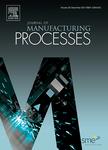版权所有:内蒙古大学图书馆 技术提供:维普资讯• 智图
内蒙古自治区呼和浩特市赛罕区大学西街235号 邮编: 010021

作者机构:Indian Inst Technol Roorkee Proc Modeling & Simulat Lab Dept Mech & Ind Engn Roorkee 247667 Uttaranchal India Natl Inst Technol Rourkela Dept Met & Mat Engn Rourkela 769008 Orissa India
出 版 物:《JOURNAL OF MANUFACTURING PROCESSES》 (J. Manuf. Processes)
年 卷 期:2025年第149卷
页 面:258-275页
核心收录:
学科分类:12[管理学] 1201[管理学-管理科学与工程(可授管理学、工学学位)] 08[工学] 0802[工学-机械工程]
基 金:Ministry of Education, India Indian Institute of Technology (IIT) Roorkee
主 题:Metal-matrix composites Microstructures Mechanical testing Twin roll continuous casting Solidification
摘 要:The fabrication of composite sheets poses significant challenges, such as ensuring uniform reinforcement distribution, clean matrix-particle interfaces, and minimizing secondary processing steps to convert billets into sheets. To address these issues, the present study utilized a twin-roll continuous casting (TRCC) process for fabricating a near-eutectic Al-Mg2Si composite sheet. A melt inlet temperature of similar to 597 degrees C was determined using a numerical simulation with dendrite coherency point (DCP) criterion for achieving optimal solidification and smooth operation during casting. Thermal analysis revealed that the time gap between nucleation and growth temperatures, along with recalescence undercooling, governs the morphology of the primary Mg2Si particles ((Mg2Si)(P)) and the eutectic (Al-Mg2Si)(E)) phases. These findings from the TRCC process were then compared with those obtained from graphite and iron molds. Graphite mold cast samples exhibited longer nucleation-to-growth times, with 2 s for primary Mg2Si and 7.1 s for the eutectic Al-Mg2Si phase, along with higher recalescence undercooling of 17.9 degrees C. In comparison, iron mold cast samples had shorter times of 1.5 and 2.1 s, respectively, and lower undercooling at 0.67 degrees C, which resulted in finer microstructures. However, in the TRCC process, preliminary cooling to the melt inlet temperature occurs before continuous casting cooling starts. This initial step increases the number of nuclei, resulting in a higher volume fraction of primary Mg2Si particles in TRCC samples compared to graphite and iron mold castings. Additionally, this controlled cooling leads to coarser particles and larger interlamellar spacing, ensuring a more uniform microstructure. Fracture surface analysis identified both ductile and brittle failure modes, which included particle fracturing, debonding, and coalescence of equiaxed microvoids. A significant challenge in TRCC, i.e., oxide formation, was mitigated by avoi